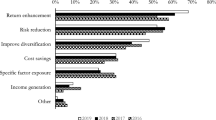Abstract
Based on the approach proposed by Blitz et al. (J Financ Markets 16:477–504, 2013 [3]), we examined the performance of the firm portfolios constructed by the residual returns from the Fama-French three factor model (Fama and French in J Financ Econ 33:3–56, 1993 [10]) by sampling the listed firms in the Taiwan Stock Market from 1990 to 2017. We show that the performance of the conventional reversal and residual reversal strategies are not significant in the Taiwan stock market. In addition, the smallest-residual portfolio outperforms conventional return reversal portfolios either with equal weighting or capital weighting. The smallest-residual portfolio also exhibits dynamic factor exposures much closer to the factor-neutral portfolio, but its dynamic factor exposures cannot fully account for the abnormal profitability.
Access this chapter
Tax calculation will be finalised at checkout
Purchases are for personal use only
Similar content being viewed by others
Notes
- 1.
- 2.
Reference [3] use only two groups and define the loser (winner) portfolio as the portfolio consisting of all the stock returns with returns lower (higher) than the cross-sectional average stock returns in previous month.
References
Avramov, D., Chordia, T., Goyal, A.: Liquidity and autocorrelations in individual stock returns. J. Financ. 61(5), 2365–2394 (2006)
Ball, R., Kothari, S., Wasley, C.E.: Can we implement research on stock trading rules? J. Portfolio Manage. 21, 54–63 (1995)
Blitz, D., Huij, J., Lansdorp, S., Verbeek, M.: Short-term residual reversal. J. Financ. Markets 16(3), 477–504 (2013)
Blitz, D., Huij, J., Martens, M.: Residual momentum. J. Emp. Financ. 18(3), 506–521 (2011)
Campbell, J.Y., Grossman, S.J., Wang, J.: Trading volume and serial correlation in stock returns. Quart. J. Econ. 108(4), 905–939 (1993)
Chang, R.P., Ko, K.-C., Nakano, S., Rhee, S.G.: Residual momentum in Japan. J. Emp. Financ. 45, 283–299 (2018)
Conrad, J., Gultekin, M.N., Kaul, G.: Profitability of short-term contrarian strategies: implications for market efficiency. J. Bus. Econ. Stat. 15(3), 379–386 (1997)
de Groot, W., Huij, J., Zhou, W.: Another look at trading costs and short-term reversal profits. J. Bank. Financ. 36(2), 371–382 (2012)
Du, D., Huang, Z., Liao, B.: Why is there no momentum in the Taiwan stock market? J. Econ. Bus. 61(2), 140–152 (2009)
Fama, E.F., French, K.R.: Common risk factors in the returns on stocks and bonds. J. Financ. Econ. 33(1), 3–56 (1993)
Grundy, B.D., Martin, J.S.M.: Understanding the nature of the risks and the source of the rewards to momentum investing. Rev. Financ. Stud. 14(1), 29–78 (2001)
Jegadeesh, N.: Evidence of predictable behavior of security returns. J. Financ. 45(3), 881–898 (1990)
Jegadeesh, N., Titman, S.: Short-horizon return reversals and the bid-ask spread. J. Financ. Intermed. 4(2), 116–132 (1995)
Lehmann, B.N.: Fads, martingales, and market efficiency. Quart. J. Econ. 105(1), 1–28 (1990)
Lin, Q.: Residual momentum and the cross-section of stock returns: Chinese evidence (2018)
Pastor, L., Stambaugh, R.: Liquidity risk and expected stock returns. J. Polit. Econ. 111(3), 642–685 (2003)
Rosenberg, B., Reid, K., Lanstein, R.: Persuasive evidence of market inefficiency. J. Portfolio Manage. 11(3), 9–16 (1985)
Wang, C.-P., Huang, H.-H., Huang, C.-C.: Momentum and contrarian profits corresponding to the coincident economic indicator on the Taiwan stock market. Emerg. Markets Financ. Trade 48(suppl 1), 29–40 (2012)
Author information
Authors and Affiliations
Corresponding author
Editor information
Editors and Affiliations
Rights and permissions
Copyright information
© 2020 Springer Nature Switzerland AG
About this paper
Cite this paper
Tzang, SW., Chang, CP., Zubairi, Y.Z., Tsai, YS. (2020). Residual Reversal Strategy: Empirical Evidence in the Taiwan Stock Market. In: Barolli, L., Xhafa, F., Hussain, O. (eds) Innovative Mobile and Internet Services in Ubiquitous Computing . IMIS 2019. Advances in Intelligent Systems and Computing, vol 994. Springer, Cham. https://doi.org/10.1007/978-3-030-22263-5_66
Download citation
DOI: https://doi.org/10.1007/978-3-030-22263-5_66
Published:
Publisher Name: Springer, Cham
Print ISBN: 978-3-030-22262-8
Online ISBN: 978-3-030-22263-5
eBook Packages: Intelligent Technologies and RoboticsIntelligent Technologies and Robotics (R0)




